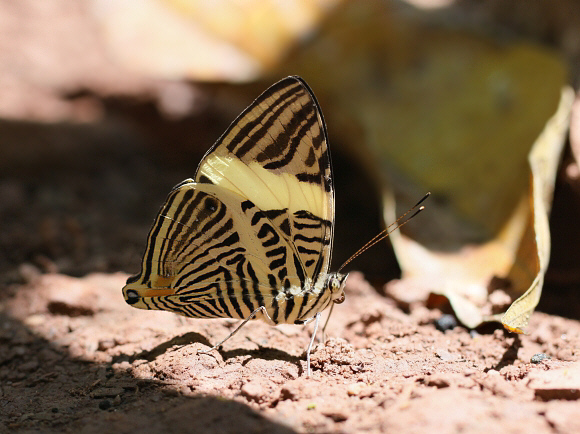
Introduction
The tribe Coeini comprises 6 genera – Colobura, Baeotus, Historis, Pycina, Smyrna and Tigridia.
There are 2 Colobura species – dirce and annulata, both found throughout the neotropical region.
Colobura annulata can be distinguished from dirce by the much narrower submarginal band on its underside forewing, and by the slightly different sub-costal markings. It was separated from dirce only in 2001, and is much less common than that species.
The butterflies habitually sit on the tree trunks in a head downwards posture, at a height of about 2 metres, to imbibe sap and moisture from crevices in the bark. If approached they sometimes try to evade the intruder by running around to the opposite side of the tree, and if followed will run back to their original position – quite literally forcing the observer to run around in circles after them. They are extremely reluctant to take flight when feeding, and if they are forced to do so they quickly return to resume feeding.
Colobura annulata is distributed from Mexico to Bolivia.
Habitats
The butterfly breeds in primary and secondary forest at altitudes between about 200-1600m.
Lifecycle
The lifecycle is unknown but is probably very similar to that of Colobura dirce given below:
The eggs are white and laid in groups of between 2-10 on leaves of the foodplant. The young larvae feed on Cecropia leaves and make ‘frass chains’ i.e. chains of droppings linked together by strands of silk, which protrude from the edges of the leaves. When not feeding they rest on these frass chains, which provide them with a defence against marauding ants. For reasons that are not fully understood, ants seem unwilling to walk over frass chains. The fully grown larvae are velvety black and adorned with white rosetted spines along the back, and yellow spines along the sides. They live and feed gregariously in groups of between 5 and 20. When feeding they bite through the stems, causing alleochemics ( anti-herbivore juices ) to bleed from the plant, stopping it from mobilising chemicals into the area being eaten. The pupa, as described by DeVries in “Butterflies of Costa Rica”, is elongate, cylindrical, and looks like a dead broken twig.
Adult behaviour
Males commonly visit orchards or other sites where there are fallen fruits. They are also sometimes seen visiting sandbanks or damp soil. At these times they tend to walk about while probing for moisture, often fanning their wings slowly as they do so.
